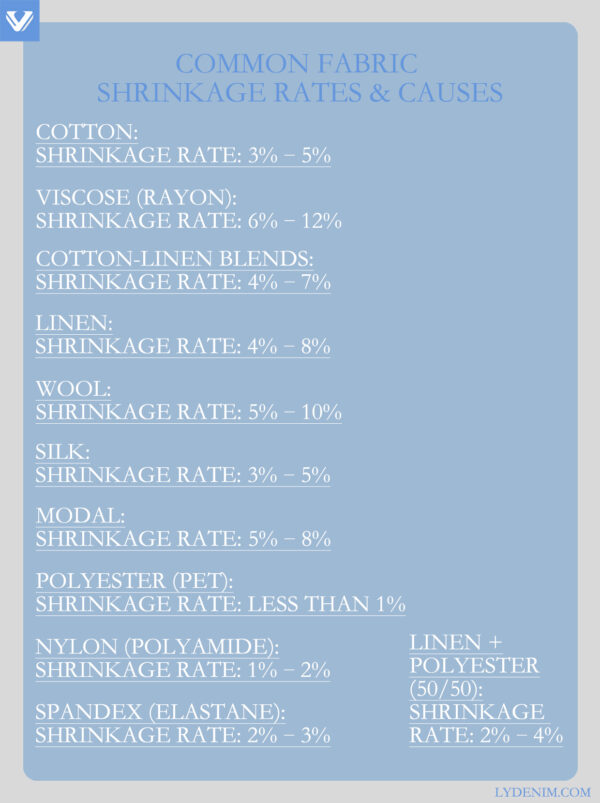Fabric Shrinkage & How to Prevent It

Estimated reading time: ~5 minutes
Understanding Fabric Shrinkage
Fabric shrinkage is a major concern in the textile and fashion industries, particularly for natural fibers like cotton, wool, and linen. When garments shrink, they lose their shape, fit, and appeal, frustrating consumers and designers alike. By understanding why fabric shrinkage occurs and how to prevent it, you can extend the life of your clothing. This guide explores shrinkage rates, causes, and actionable prevention tips, drawing from expert insights to keep your fabrics looking their best.
Why Does Fabric Shrink?
Shrinkage happens when fibers react to moisture, heat, or mechanical stress, causing them to contract. Natural fibers are especially prone due to their absorbency and structural properties. According to textile studies, shrinkage rates vary by material, with untreated fabrics showing higher contraction—up to 12% in some cases. Below, we break down common fabrics, their shrinkage rates, and why they shrink.
Shrinkage Rates and Causes
- Cotton
- Shrinkage Rate: 3%–5%
- Cause: Cotton fibers swell with moisture and contract during drying due to fiber realignment.
- Uses: T-shirts, bed linens, casual shirts.
- Viscose (Rayon)
- Shrinkage Rate: 6%–12%
- Cause: Low wet strength causes stretching when wet and sharp contraction when dry.
- Uses: Dresses, loungewear, underwear.
- Cotton-Linen Blends
- Shrinkage Rate: 4%–7%
- Cause: Combines cotton’s moisture absorption with linen’s tension release during washing.
- Uses: Summer apparel, tablecloths.
- Linen
- Shrinkage Rate: 4%–8%
- Cause: Stiff fibers relax under water, releasing weaving tension.
- Uses: Shirts, curtains, lightweight jackets.
- Wool
- Shrinkage Rate: 5%–10%
- Cause: Wool scales interlock when wet, leading to wool felting and tightening.
- Uses: Sweaters, coats, scarves.
- Wool Blends
- Shrinkage Rate: Varies; significant if chemical fibers are <30%.
- Cause: Wool’s felting dominates unless synthetic fibers reduce contraction.
- Silk
- Shrinkage Rate: 3%–5%
- Cause: Protein fibers swell with water; un-pre-shrunk yarns contract.
- Uses: Qipaos, scarves, sleepwear.
-

Shrinkage Rate
Modal
-
Shrinkage Rate: 5%–8%
-
Why: Loose fiber structure leads to tightening after multiple washes.
-
Typical Uses: Underwear, towels.
Polyester (PET)
-
Shrinkage Rate: Less than 1%
-
Why: Low absorbency, high thermal stability.
Nylon (Polyamide)
-
Shrinkage Rate: 1%–2%
-
Note: Highly durable, shrinkage is minimal.
Spandex (Elastane)
-
Shrinkage Rate: 2%–3%
-
Why: Minimal shrinkage in blends due to elastic nature.
Linen + Polyester (50/50)
-
Shrinkage Rate: 2%–4%
-
Typical Uses: Summer shirts offering both breathability and anti-shrink properties.

Shrinkage Rate
10 Tips to Prevent Fabric Shrinkage
Preventing fabric shrinkage ensures your garments stay true to size. Here are 10 expert tips:
- Choose Pre-Shrunk Fabrics: Opt for sanforized or pre-washed materials to reduce shrinkage below 3%.
- Check Care Labels: Follow manufacturer instructions for washing and drying.
- Use Cold Water: Wash at 30–40°C to minimize fiber swelling, especially for cotton and viscose.
- Avoid Hot Dryers: High heat triggers contraction; air dry flat instead.
- Turn Garments Inside Out: Protects surface fibers and reduces stress during washing.
- Use Gentle Cycles: Low agitation prevents excessive fiber movement in wool and silk.
- Avoid Overloading Washers: Gives fabrics space to move without stress.
- Dry Flat: Lay garments on a towel to maintain shape, especially for linen and wool blends.
- Test Before Washing: For raw denim or untreated fabrics, test a small area first.
- Professional Cleaning: For delicate fabrics like silk, opt for dry cleaning to avoid shrinkage risks.
Pros and Cons of Shrink-Prone Fabrics
Understanding the trade-offs of shrink-prone fabrics helps with informed choices. According to LYDenim’s fabric guide:
- Pros:
- Natural Fibers: Cotton, linen, and wool offer breathability, comfort, and eco-friendliness.
- Unique Aesthetics: Fabrics like raw denim develop personalized fading patterns.
- Cons:
- Shrinkage Risk: High contraction rates (e.g., 6–12% for viscose) alter fit.
- Maintenance Needs: Require careful washing to avoid wool felting or distortion.
Related: Explore denim weaves in LYDenim’s weave structure guide.
Conclusion
Fabric shrinkage is a challenge, but with the right knowledge and care, you can protect your garments. From cotton shrinkage to wool felting, understanding each material’s behavior empowers better maintenance. By following these 10 tips, you can minimize shrinkage and keep your clothes fitting perfectly. For more textile insights, visit our guides on Denim Care Tips or Textile Maintenance.
Customization Services by LYDENIM
🎨 Looking for custom stretch denim or shrink-resistant apparel? LYDENIM specializes in tailor-made solutions to meet your design and production needs.
🛍️ Explore & Get Inspired: Browse our fabric selections and discover design ideas on LYDenim.
🌐 Elastic Clothing: Check out our offerings on MyAlibaba. 📩 Contact Us: Reach out at malone@lydenim.com.
Create your denim masterpiece with LYDENIM—your trusted partner for stretch fabric and custom denim solutions.
